
Nothoscordum is a genus of New World plants in the onion tribe within the Amaryllis family. It is probably paraphyletic. The genus is native to North, Central and South America, though a few species have become naturalized in various parts of the Old World.

Tigridia, is a genus of bulbous or cormous flowering plants belonging to the family Iridaceae. With common names including peacock flowers, tiger-flowers or shell flowers, they have large showy flowers; and one species, Tigridia pavonia, is often cultivated for this. The approximately 60 species in this family grow in the Americas, from Mexico down to Chile.

Olsynium is a genus of summer-dormant rhizomatous perennial flowering plants in the iris family Iridaceae, native to sunny hillsides in South America and western North America.

Ophryosporus is a genus of South American flowering plants in the tribe Eupatorieae within the family Asteraceae.

Orthrosanthus is a genus of flowering plants in the family Iridaceae first described as a genus in 1827. It is native to Australia, Mexico, Central and South America.

Nemastylis, or pleatleaf, is a genus of flowering plants in the family Iridaceae, first described as a genus in 1835. It is native to Mexico, Central America, and the southern part of the United States. The genus name is derived from the Greek words nema, meaning "thread", and stylos, meaning "pillar" or "rod".
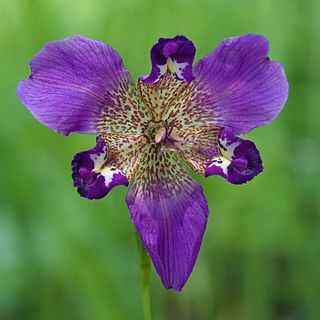
Alophia is a small genus of perennial, herbaceous and bulbous plants in the family Iridaceae. The genus comprise five known species that occur from the South-central United States as well as in Mexico, Central America, and parts of South America.
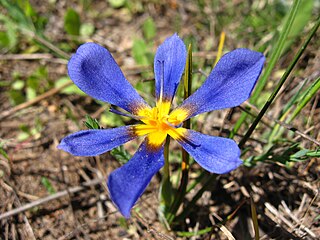
Calydorea is a small genus of perennial, herbaceous and bulbous plants in the family Iridaceae native to Mexico and South America. The plants in the genus are small with tunicated bulbs. The flowers are light blue, violet, white, or yellow, depending on the species, of which there are around twenty. Taxonomists considered that the already known genera Salpingostylis, Cardiostigma, Catila and Itysa are not enough different from each other to justify their taxonomic segregation and, for this reason, all of them are now included in Calydorea.

Cypella is a genus of herbaceous, perennial and bulbous plants in the family Iridaceae. It is distributed in South America, from Peru and Brazil to Northern Argentina. The genus name is likely derived from the Greek word kyphella, meaning "hollow of the ear", and alludes to the shape of the inner tepals.
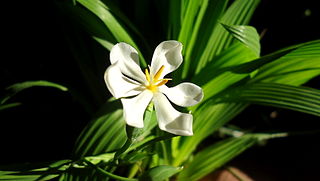
Eleutherine is a genus of herbaceous, perennial and bulbous plants in the family Iridaceae, first described as a genus in 1843. It is native to Latin America and the West Indies.

Ennealophus is a genus of perennial, herbaceous and bulbous plants in the family Iridaceae. It consists in five species distributed from Ecuador to Northern Brazil and Northwest Argentina. The genus name is derived from the Greek words ennea, meaning "nine", and lophus, meaning "crest".
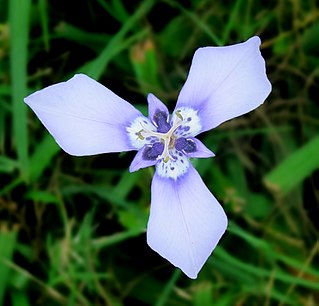
Herbertia is a small genus of herbaceous, perennial and bulbous plants in the family Iridaceae.

Olyra is a genus of tropical bamboos in the grass family. It is native primarily to the Western Hemisphere, with one species extending into Africa.

Flourensia is a genus of flowering plants in the family Asteraceae. It contains subshrubs and shrubs, which are commonly known as tarworts. They are found in the southwestern United States, Mexico, Central America, and South America. The genus name honours French physiologist Jean Pierre Flourens (1794–1867).
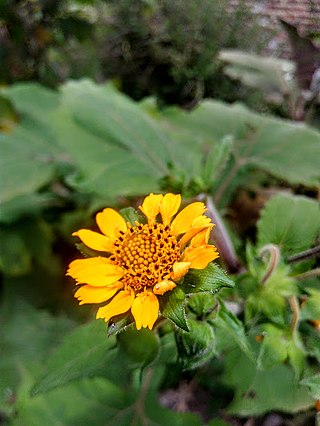
Microliabum is a genus of South American flowering plants in the family Asteraceae.
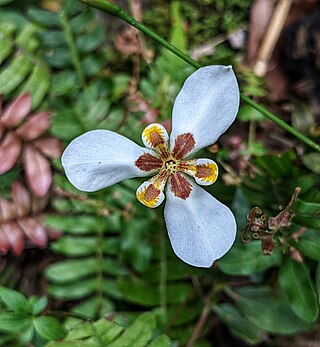
Hesperoxiphion is a genus of flowering plants in the family Iridaceae, first described as a genus in 1877. It is native to northwestern South America. The genus name is derived from the Greek words hesperos, meaning "western", and xiphos, meaning "sword".
Larentia is a genus of flowering plants in the family Iridaceae, first described as a genus in 1882. It is native to Mexico and South America.

Stenomesson is a genus of bulbous plants in the family Amaryllidaceae. All the species are native to western South America.

Hieronymiella is a genus of flowering plants in the Amaryllis family. It is native to Bolivia and north-western Argentina.

Philibertia is a genus of flowering plants in the family Apocynaceae, first described as a genus in 1819. It is native to South America.



















